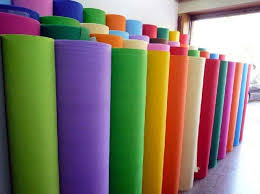The Ultimate Guide to Non-Woven Fabric
- Get link
- X
- Other Apps
Non-woven fabric has become an integral part of our daily lives, playing a crucial role in various industries and applications. From healthcare and hygiene products to automotive and agriculture sectors, the versatility and functionality of non-woven fabric make it a popular choice for manufacturers and consumers alike. In this comprehensive guide, we'll explore everything you need to know about non-woven fabric, with insights from industry leader Jhanji Textiles.
What is Non-Woven Fabric?
Non-woven fabric is a type of textile that is made directly from synthetic fibers or filaments without the need for spinning or weaving. Instead, fibers are bonded together mechanically, chemically, or thermally to form a fabric-like material. This unique manufacturing process gives non-woven fabric its distinctive properties, such as durability, breathability, and versatility.
Types of Non-Woven Fabric
1. Spunbond Non-Woven Fabric
Spunbond non-woven fabric is made by spinning continuous filament fibers onto a moving belt. The fibers are then bonded together using heat or chemicals. Spunbond fabric is lightweight, breathable, and tear-resistant, making it ideal for applications like disposable medical gowns, hygiene products, and agricultural covers.
2. Meltblown Non-Woven Fabric
Meltblown non-woven fabric is produced by melting and extruding polypropylene or other thermoplastic resins to form a fine fiber mesh. The fibers are then cooled and stretched to create a web-like structure. Meltblown fabric is known for its high filtration efficiency and is commonly used in face masks, air filters, and surgical drapes.
3. Needle-Punched Non-Woven Fabric
Needle-punched non-woven fabric is made by mechanically interlocking fibers together using barbed needles. This process creates a dense and durable fabric that is often used in automotive interiors, carpet underlays, and geotextiles.
4. Spunlace Non-Woven Fabric
Spunlace non-woven fabric is produced by entangling fibers using high-pressure water jets. This results in a soft and smooth fabric that is often used in wipes, medical dressings, and hygiene products.
Advantages of Non-Woven Fabric
Cost-Effective: Non-woven fabric is generally more cost-effective to produce than traditional woven fabrics, making it a preferred choice for mass-produced items.
Versatility: Non-woven fabric can be customized to meet specific requirements, making it suitable for a wide range of applications across various industries.
Durability: Non-woven fabric is often more durable and long-lasting than traditional fabrics, making it ideal for applications that require strength and resilience.
Applications of Non-Woven Fabric
1. Healthcare and Hygiene Products
Non-woven fabric is widely used in healthcare and hygiene products such as surgical gowns, face masks, diapers, and sanitary pads due to its softness, breathability, and high absorbency.
2. Automotive Industry
In the automotive industry, non-woven fabric is used for interior trims, upholstery, and insulation due to its durability, sound absorption, and thermal insulation properties.
3. Agriculture
Non-woven fabric is used in agriculture for crop protection, weed control, and frost protection. It helps to retain moisture, control temperature, and protect crops from pests and diseases.
4. Construction and Geotextiles
Non-woven fabric is used in construction for erosion control, drainage systems, and reinforcement due to its strength, durability, and permeability.
Jhanji Textiles: A Leader in Non-Woven Fabric Manufacturing
When it comes to non-woven fabric manufacturing, Jhanji Textiles stands out as a leader in the industry. With state-of-the-art manufacturing facilities, a diverse product portfolio, and a commitment to quality and innovation, Jhanji Textiles has earned a reputation for excellence. Whether you're looking for spunbond, meltblown, needle-punched, or spunlace non-woven fabric, Jhanji Textiles offers a wide range of high-quality products to meet your specific requirements.
Conclusion
Non-woven fabric is a versatile and functional material that has revolutionized various industries and applications. From healthcare and automotive to agriculture and construction, the uses of non-woven fabric are virtually limitless. As demand for non-woven fabric continues to grow, manufacturers like Jhanji Textiles are leading the way with innovative products, state-of-the-art manufacturing processes, and a commitment to quality and customer satisfaction.
Whether you're a manufacturer looking for high-quality non-woven fabric for your products or a consumer interested in learning more about this versatile material, this ultimate guide to non-woven fabric aims to provide you with valuable insights and information. With Jhanji Textiles as your trusted partner in non-woven fabric manufacturing, you can be confident that you're getting the best quality products that meet your specific needs and requirements.
- Get link
- X
- Other Apps




Comments
Post a Comment